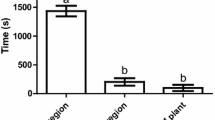Abstract
Infochemicals mediate communication within and between different trophic levels. In this study, we identified a new type of plant allomone induced by a plant pathogen and perceived by its vector insect Cacopsylla picta. This phloem-feeding psyllid is the main vector of Candidatus Phytoplasma mali, a cell wall-lacking bacterium that causes the so-called apple proliferation disease. In a previous study, we showed that newly emerged females of C. picta were attracted by the odor of phytoplasma-infected apple plants (Malus domestica), which release ß-caryophyllene in contrast to uninfected plants. Here, the attractiveness of this sesquiterpene for C. picta was confirmed in both olfactometer bioassays and field studies. Synthetic ß-caryophyllene was highly attractive to newly emerged adults of C. picta both when offered simultaneously with healthy apple odor and without. The psyllid’s response was independent of its odor experience and infection status. These results confirm our previously established hypothesis that this phytoplasma manipulates the behavior of its vector insect by changing the odor blend of its host plant. Deployed in apple orchards, sticky traps baited with ß-caryophyllene dispensers caught both males and females of C. picta. Consequently, this new type of infochemical, i.e., a phytopathogen-induced plant allomone, represents a promising compound to develop innovative techniques for monitoring or maybe even mass trapping of C. picta.


Similar content being viewed by others
References
Dicke, M., and Sabelis, M. W. 1988. Infochemical terminology: based on cost-benefit analysis rather than origin of compounds? Funct. Ecol. 2:131–139.
Frisinghelli, C., Delaiti, L., Grando, M. S., Forti, D., and Vindimian, M. E. 2000. Cacopsylla costalis (Flor 1861), as a vector of apple proliferation in Trentino. J. Phytopathol. 148:425–431.
Khalilova, A. Z., Paramonov, E. A., Odinokov, V. N., and Khalilov, L. M. 1998. Identification and biological activity of volatile organic substances emitted by plants and insects. 1. Components of the native scents of Leptinotarsa decemlineata and Solanum tuberosum. Chem. Nat. Comp. 34:647–649.
Mayer, C. J., Vilcinskas, A., and Gross, J. 2008a. Phytopathogen lures its insect vector by altering host plant odor. J. Chem. Ecol. 34:1045–1049.
Mayer, C. J., Jarausch, B., Jarausch, W., Vilcinskas, A., and Gross, J. 2008b. Cacopsylla melanoneura has no relevance as vector of apple proliferation in Germany. Phytopathology (in press)
Mumm, R., Posthumus, M. A., and Dicke, M. 2008. Significance of terpenoids in induced indirect plant defence against herbivorous arthropods. Plant Cell Environ. 31:575–585.
Rasmann, S., Köllner, T. G., Degenhard, J., Hiltpold, I., Toepfer, S., Kuhlmann, U., Gershenzon, J., and Turlings, T. 2005. Recruitment of entomopathogenic nematodes by insect-damaged maize roots. Nature 434:732–737.
Rostás, M., Simon, M., and Hilker , M. 2003. Ecological cross effects of induced plant responses towards herbivores and phytopathogenic fungi. Basic Appl. Ecol. 4:43–62.
Schnee, C., Kollner, T. G., Held, M., Turlings, T. C. J., Gershenzon, J., and Degenhardt, J. 2006. The products of a single maize sesquiterpene synthase form a volatile defense signal that attracts natural enemies of maize herbivores. Proc. Natl. Acad. Sci. USA 103:1129–1134.
Seemüller, E., and Schneider, B. 2004. ‘Candidatus Phytoplasma mali’, ‘Candidatus Phytoplasma pyri’ and ‘Candidatus Phytoplasma prunorum’, the causal agents of apple proliferation, pear decline and European stone fruit yellows, respectively. Int. J. Syst. Evol. Microbiol. 53:1217–1226.
Seemüller, E., Garnier, M., and Schneider, B. 2002. Mycoplasmas of plants and insects, pp. 91–116, in S. Razin, and R. Herrmann (eds.). Molecular Biology and Pathology of Mycoplasmas. Kluwer Acad. Publ., London.
Stout, M. J., Thaler, J. S., and Thomma, B. P. H. J. 2006. Plant-mediated interactions between pathogenic microorganisms and herbivorous arthropods. Annu. Rev. Entomol. 51:663–689.
Acknowledgements
This work was funded by the German Research Foundation (DFG GR 2645/1,2). J.G. is grateful to the Stifterverband für die Deutsche Wissenschaft for additional funding (innovative research award). We thank Jürgen Just and Kai Lukat for excellent technical assistance and Eva Gross for linguistic improvements.
Author information
Authors and Affiliations
Corresponding author
Rights and permissions
About this article
Cite this article
Mayer, C.J., Vilcinskas, A. & Gross, J. Pathogen-induced Release of Plant Allomone Manipulates Vector Insect Behavior. J Chem Ecol 34, 1518–1522 (2008). https://doi.org/10.1007/s10886-008-9564-6
Received:
Revised:
Accepted:
Published:
Issue Date:
DOI: https://doi.org/10.1007/s10886-008-9564-6




